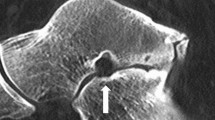Abstract
Tarsal coalitions have only very infrequently been observed in the context of cavus foot abnormalities. Recognizing this diagnosis could be crucial to effective cavus repair. We report tarsal coalitions observed in cavus deformity here. Between 2022 and 2023, the records of every patient treated by one of the authors for a varus deformity who was later determined to have either a unilateral or bilateral tarsal coalition were examined. Two patients with cavus deformities who were treated by one of the authors have either a unilateral or bilateral tarsal coalition. Three foot (medial cuneiform–navicular n = 1 and calcaneonavicular n = 2) with tarsal coalition were examined. All of these cases occurred in patients with idiopathic cavus deformity. Computed tomography scans were used to make a firm diagnosis for each patient. We advise surgeons to keep an awareness for this potential comorbid issue in all cavus foot abnormalities and to take advanced imaging into consideration. In these uncommon cases, the medial cuneiform–navicular and calcaneonavicular joints formed an osseous coalition with pes cavus deformity, which successfully resolved with conservative and surgical treatment, respectively. Level of Clinical Evidence: IV.










Similar content being viewed by others
Data availability
A data availability statement is not applicable for this study.
References
Hollander, J., Dusoswa, Q., Dahmen, J., Sullivan, N., Kerkhoffs, G., & Stufkens, S. (2022). 8 out of 10 patients do well after surgery for tarsal coalitions: a systematic review on 1284 coalitions. Foot and Ankle Surgery, 28(7), 1110–1119.
Scranton, P. J. (1987). Treatment of symptomatic talocalcaneal coalition. J Bone Jt. Surgery America., 69(4), 533–539.
Khoshbin, A., Law, P., Caspi, L., & Wright, J. (2013). Long-term functional outcomes of resected tarsal coalitions. Foot and Ankle International, 34(10), 1370–1375.
Carli, A., Leblanc, E., Amitai, A., & Hamdy, R. (2014). The evaluation and treatment of pediatric tarsal coalitions: a critical analysis review. JBJS Review., 2(8), e2.
Stuecker, R., & Bennett, J. (1993). Tarsal coalition presenting as a pes cavo-varus deformity: report of three cases and review of the literature. Foot & Ankle, 14(9), 540–544.
Charles, Y., Louahem, D., & Diméglio, A. (2006). Cavovarus foot deformity with multiple tarsal coalitions: Functional and three-dimensional preoperative assessment. Journal of Foot and Ankle Surgery, 45(2), 118–126.
Kurashige, T., & Suzuki, S. (2015). Tibialis Spastic Varus Foot With Calcaneonavicular Coalition: A Case Report and Review of the Literature. Foot Ankle Specialist., 8(6), 532–536.
Oestreich, A., Mize, W., Crawford, A., & Morgan, R. J. (1987). The “anteater nose”: A direct sign of calcaneonavicular coalition on the lateral radiograph. Journal of Pediatric Orthopaedics, 7(6), 709–711.
Harris, R., & Beath, T. (1948). Etiology of peroneal spastic flat foot. The Journal of Bone and Joint Surgery. British volume, 30(4), 624–634.
Riccio A (2021) Tarsal Coalition, in Tachdjian’s Pediatric Orthopaedics: From the Texas Scottish Rite Hospital for Children, Elsevier 747
Simmons, E. (1965). Tibialis spastic varus foot with tarsal coalition. Journal Bone Jt Surgery Br., 47, 533–536.
Maudsley, R. (1956). Spastic pes varus. Proceedings of the Royal Society of Medicine, 49(4), 181.
Van Rysselberghe, N., Souder, C., & Mubarak, S. (2020). Unsuspected tarsal coalitions in equinus and varus foot deformities. Journal of Pediatric Orthopaedics B, 29(4), 370–374.
Barrett, S., & Johnson, J. (2004). Progressive bilateral cavovarus deformity: an unusual presentation of calcaneonavicular tarsal coalition. American Journal of Orthopedics, 33(5), 239–242.
Cowell, H. (1972). Talocalcaneal coalition and new causes of peroneal spastic flatfoot. Clinical Orthopaedics and Related Research, 85, 16–22.
Kumar, S., Guille, J., Lee, M., & Couto, J. (1992). Osseous and non-osseous coalition of the middle facet of the talocalcaneal joint. The Journal of Bone & Joint Surgery, 74(4), 529–535.
Imai, K., Ikoma, K., Kido, M., Maki, M., Arai, Y., Fujiwara, H., & Kubo, T. (2016). Nonosseous tarsal coalition of the lateral cuneocuboid joint: a case report. Journal of Foot and Ankle Surgery, 55(5), 1072–1075.
Acknowledgements
The study was carried out in Bezmialem Vakif University Orthopedics and Traumatology Department.
Funding
The authors declare that no funds, grants, or other support were received during the preparation of this manuscript.
Author information
Authors and Affiliations
Contributions
All authors have read and agreed to this manuscript being submitted for publication. All listed authors meet the criteria, and nobody who qualifies for authorship has been omitted from the list. Contributors have been properly acknowledged, and all authors and contributors have approved their being listed and/or acknowledged. MAI conceived the idea of the study and supervised the IRB proposal, study design, collection of data and wrote the first and edited subsequent drafts. SO and MAG worked in collection and analysis of the data. GU and HS participated in study design and edited the subsequent drafts.
Corresponding author
Ethics declarations
Conflict of Interest
The authors have no relevant financial or non-financial interests to disclose.
Ethical Standard Statement
Ethical approval not required as per our institute review board. All procedures performed in this study involving human participants were in accordance with the ethical standard of the institutional and/ international research committee and with the 1964 Helsinki declaration and its later amendments or comparable ethical standards.
Informed Consent
Patients and their parents were informed that data concerning the case would be submitted for publication, and they provided consent.
Additional information
Publisher's Note
Springer Nature remains neutral with regard to jurisdictional claims in published maps and institutional affiliations.
Rights and permissions
Springer Nature or its licensor (e.g. a society or other partner) holds exclusive rights to this article under a publishing agreement with the author(s) or other rightsholder(s); author self-archiving of the accepted manuscript version of this article is solely governed by the terms of such publishing agreement and applicable law.
About this article
Cite this article
İncesoy, M.A., Uzer, G., Orujov, S. et al. Cavus Foot Deformity with Calcaneonavicular and Medial Cuneiform–Navicular Coalition: A Case Series. JOIO 57, 1906–1911 (2023). https://doi.org/10.1007/s43465-023-00979-3
Received:
Accepted:
Published:
Issue Date:
DOI: https://doi.org/10.1007/s43465-023-00979-3




